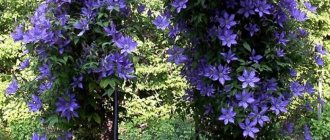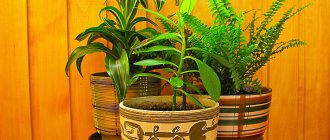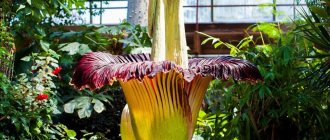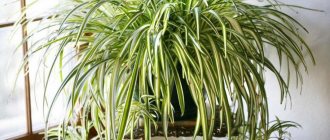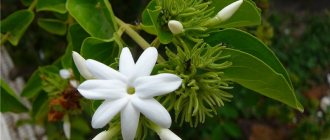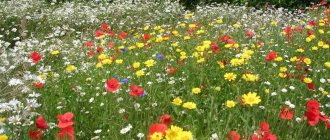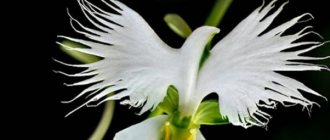A corner of paradise, where everything around is fragrant and pleasing to the eye... Is this how you want your garden to look in moments of relaxation?
It’s a completely understandable desire, and we’ll tell you how to make it come true. How to turn your plot into a fragrant paradise?
A breath of fresh air is our first impression after a flight when we arrive at a distant resort. At these moments we feel the changes especially acutely - the south greets us with aromas. Having reached the final point of the journey, we see that it could not be otherwise: not only the flowers are fragrant, but also the trees and shrubs.
Sources of pleasant odors do not always reveal themselves at first sight. Sometimes you have to come close to see small and not very interesting flowers or be surprised to discover that it’s not the flowers that smell, but the leaves or pine needles. Northern nature is poorer in aromas, but in the garden we can collect them into a “bouquet” sufficient to turn a summer cottage into a fragrant paradise.
What is needed for this? It would seem that everything is very simple: plant more fragrant plants. But remember: pinpoint “inclusions” of aromas will dissolve in space, so it makes sense to “increase the concentration.” It is clear that the contribution from a hedge of lilac or jasmine is incomparably greater than from a separate bush, and the aroma from a wide strip of snowdrops and corydalis planted under it spreads further than from a small curtain in a flowerbed.
Important : each fragrant plant has its own “critical mass” at which it is able to make itself known from a distance. It is this factor that is worth focusing on.
Crown jasmine or garden jasmine (Philadelphus coronarius) is an excellent choice for a fragrant hedge.
There is one more important nuance: most often, we are primarily attracted by the beauty of plants, and not by their aroma. Therefore, when creating a fragrant corner, we are faced with a contradiction, discovering that our favorite plants sometimes try to slightly deceive us, not meeting our expectations. But this problem can be corrected, because the same garden crop is often represented by both fragrant and odorless varieties. On the one hand, peonies, lilies and roses also have varieties without fragrance, which in our minds “should” be fragrant.
On the other hand, pleasant surprises also happen where we don’t expect them. For example, in a sea of scentless tulips, there are masterpieces not only in beauty, but also in aroma.
Advice: without giving up your favorite plants, find among them varieties that, by more fully affecting the senses, give rise to more pleasant emotions. Among the beauties of lilies (on the left), the most fragrant are oriental hybrids. It is better to buy tobacco and heliotrope (on the right) as seedlings, then you definitely can’t go wrong with the choice of variety
Indoor rose
Indoor roses are miniature bushes no more than 40 cm high, with charming small flowers of different shades. The plant loves good lighting; in a dark room it loses its beautiful appearance and stops blooming.
Some varieties of roses exude a subtle, subtle aroma that contains fruity notes, while others are so fragrant that they can cause a headache. Therefore, it is better not to place them in the bedroom.
Iris
Photo from the archive of Natalia Tkachenko
Iris is also characterized not only by a varied palette of colors, but also by many bright aromas - vanilla, honey, caramel, chocolate, with tart citrus notes.
The smell of each iris is unique and is most pronounced in the first days after the bud opens.
In order for irises to delight you with their flowering and aroma, plant them in sunny places.
- Bearded and beardless irises: names of species with descriptions and photos
Do you want to plant irises of different colors, but don’t know which ones are best? We have collected all types in our material, from dwarf to the tallest.
Gardenia
Snow-white double flowers of gardenia enchant with a delicate and fresh jasmine aroma. Growing this tropical beauty is not easy, it is capricious, so it is necessary to create comfortable conditions.
The plant prefers acidified soil, warmth, good lighting and high humidity. However, direct sunlight is harmful to gardenias.
When the period of bud formation and flowering begins (from July to October), you cannot move the pot. This will cause the inflorescences to drop.
Arabian jasmine
This is one of the best varieties that winter well in our area. To achieve annual flowering, it is important to prune the branches in the first days of spring, and then pinch the tops once a month. This will allow the plant to branch well.
Jasmine is protected from sudden changes in temperature, drafts and grown in a warm place. The flowering period lasts from early spring to mid-autumn. Distributes an intense sweetish odor with a salty aftertaste. At first there are few buds, but the bush becomes more luxuriant every year.
Orchid Corsage
The flowers of this elegant orchid variety smell incredibly delicious, which evokes associations with confectionery products. Vanilla notes add exoticism to bright flowers.
For a beauty from the tropics, it is advisable to provide bright, diffused light. If it stands in the shade, then you should not expect flowers. It tolerates rare watering normally, but excess moisture can lead to death for the orchid.
African Hydnora
In the deserts of the southern African continent, this specimen is often found in the wild. Gidnora emerges from the sand after heavy rains. This is a parasitic plant, the roots of which cling underground to the shoots of the root system of other plants and extract water and nutrients for themselves. An open African Hydnora flower with thick-skinned petals exudes the aroma of excrement. Despite the terrible stench, aborigines and desert-dwelling animals eat exotic fruits and seeds.
Iberis
Iberis
Iberis has a modest appearance, but has an incredible aroma. The flowering of the plant lasts for a month. The most famous variety is bitter iberis, which has white inflorescences. The umbrella type of plant is also popular; it has lilac-pink flowers. This variety is also actively used for growing on loggias and balconies.
Where is the best place to place strong-smelling flowers in the garden?
When planting garden flowers and shrubs with scent, you should focus on specific areas. For example, plant fragrant flowers in a flower bed or along paths closer to the house, and shrubs near a gazebo or fence.
In sunny places
Roses do well in open sunny areas. They need not only sun, but also air circulation. This place is also suitable for planting aromatic herbs and annual flowers. Petunias, oregano, and sage like to grow in sunny areas.
In the direction of wind movement
The direction of the wind is important. If it is not possible to plant plants where you want to enjoy their aroma, it is worth studying the direction of the prevailing winds. Plant fragrant flowers so that their aroma is carried by the wind to the gazebos and benches near the house, where you spend most of the time.
Inside a confined space
The opposite of the previous option will be the concentration of the smell in a certain area. The construction of a bosquet, a high fence or border that will prevent odors from moving beyond their boundaries will help to enclose it in space.
When planting fragrant flowers and shrubs in the local area, it is important to be guided by your preferences. Some people like delicate scents, others like strong, spicy scents. In any case, these plants will decorate the area and will provide pleasant moments for a long time.
Sweet pea
Sweet pea has been known for a long time both in the West and in the East.
When choosing flowers for the garden, many people advise paying attention to sweet peas. Plants with purple flowers are considered the most fragrant; it is better to choose varieties that were bred a long time ago. New hybrids are visually attractive, but their smell is weaker. Sweet peas are ideal for growing in central Russia, as they grow best in cool weather.
Recent Entries
Chainsaw or electric saw - what to choose for the garden? 4 mistakes when growing tomatoes in pots that almost all housewives make Secrets of growing seedlings from the Japanese, who are very sensitive to the soil
The flowers have an intoxicating sweet aroma that can spread over long distances. This is a unique combination of the smell of meadow grass, honey, and flowers.
The flowering period lasts from June to November.
The seeds are sent to the soil after the snow melts. In closed ground they can be sown at the end of winter. To speed up the germination process, it is better to soak the seeds for 12 hours. After planting, it is recommended to mulch the soil. It will help preserve the plant during sudden night frosts. In summer, mulch is necessary to prevent the roots from overheating and the soil from drying out too quickly.
Features of cultivation:
- It is necessary to plant peas near nets and trellises so that the plant has the opportunity to climb;
- dried flowers need to be cut to stimulate the flowering process;
- The plants require regular watering; when there is drought, the buds fall off.
You can stimulate the process of active flowering if you add complex fertilizer to the soil 2-3 times a season.
I absolutely love the aroma of sweet peas on a summer evening after watering! Thanks to it, I not only enjoy the aroma, but also the old fence in the yard is being improved, which would be broken, but it would be a pity to unite the yard. Convenient zoned parts. The peas are not whimsical, docile, they like to grow tall, but I try to pinch them so that they bush better!
Pink
https://otzovik.com/review_4588149.html
Scientific explanation
The smell of flowers captivated even such a baby
It is quite difficult to explain why the scent of flowers is felt from a distance, because the plant itself does not move. There is an opinion that it is insects that spread the scent of flowers over long distances, since the flower itself cannot do this. However, this is not connected in any way; insects only collect pollen and transfer nectar, which subsequently has a beneficial effect on plant reproduction.
Flowering plants contain aroma molecules, which, under certain external temperatures, dissolve into the environment and are carried through the air due to diffusion processes. It is these molecules that give a person a unique feeling of the fragrant aroma of flowers. The molecules, reaching the nasal receptors, allow you to feel the whole range of shades of smell embedded in a single bouquet of floral aroma.
Murraya paniculata
This evergreen plant attracts visitors with its glossy, bright green leaves that appear to be coated with wax. During flowering, it is decorated with small snow-white bells, the smell reminiscent of a combination of the delicate floral aroma of jasmine with light notes of energetic orange.
The first buds appear in the sixth year and delight the owner only 2 times a year. Red edible fruits are then produced which can be dried and used as a seasoning.
Peony
Photo from the archive of Natalia Tkachenko
Its delicate fragrance is one of its main advantages. In China, the smell of peony is described as “a hundred roses in one flower.”
Peony flowering begins in May and continues until mid-summer, depending on the variety.
Prefers bright sunlight in the morning and evening and diffused light or light partial shade on hot afternoons. Grows best on slightly acidic loam. Infrequent but abundant watering is required.
- 9 fantastically beautiful varieties of tree peony
Magnificent peonies that will take your breath away!
Lily
Photo from the archive of Natalia Tkachenko
Oriental, longiflorum and trumpet lilies are characterized by the strongest aroma in the kingdom of these beauties. They have a specific smell, sometimes it is felt far from the place of growth and, unfortunately, not everyone will like it. Therefore, before planting a lily on your site, ask what species it belongs to. Lilies bloom throughout the season, replacing each other.
They prefer loose, fertile, well-moistened and drained soil. Mostly bright sunlight. For abundant flowering, lilies are fed three times a season: before shoots appear, during budding and after flowering.
The more flowers you plant, the brighter the aroma will be.
- Which lilies smell the most (varieties with photos)
When choosing plants for your site, you should not rely solely on visual characteristics. Remembering the right combination of shapes, shades and textures, you should not discount smells.
Features of growing eucharis (video)
Any parts of the following indoor ornamental crops have a pleasant, pronounced aroma:
- the coniferous plant Araucaria is often grown at home and is characterized by a pleasant coniferous smell, and is also capable of saturating the air with beneficial phytoncides;
- indoor mint or Plectranthus is highly valued by indoor gardeners due to its ease of care and decorative attractiveness of the foliage;
- The evergreen perennial Myrtle has leathery leaves and single or numerous white flowers, collected in short racemes.
When placing fragrant plants in the house, you need to remember that fragrant crops are not recommended to be grown in the bedroom and children's room.
Geranium
Thanks to its essential oils, geranium is popularly known as a room doctor. No wonder, because it removes toxins, relieves tension and even helps with headaches and insomnia.
Geranium does not contain poisons, but it can harm its owner. For example, if he is allergic or asthmatic. In young children and pregnant women, this plant can also cause allergies, be it tearing, coughing or rash.
Geranium is also unsafe for pets: if they eat its flowers or leaves, they can become seriously poisoned. But if you don’t have curious small children or animals, and your apartment is infested with cockroaches and moths, you can safely place it on the windowsill—not a trace of the parasites will remain.

